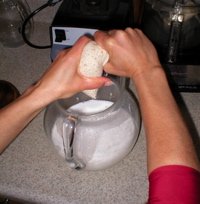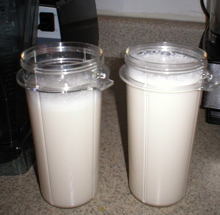Make Your Own
Delicious Almond Milk
Almond milk is creamy, tasty, and full of nutrients. Used in the Middle East for centuries for its stability and availability, almonds are one of the healthiest nuts around, a great source of nutrition.
Why Almond Milk?
- Lactose free
- Good option for folks with food allergies to soy, cow's milk, or rice
- Tastes great
- Easy to make
- Fresh and no added ingredients (sugars, preservatives, etc.)
- Make it thin or think, whatever you prefer it
- No cholesterol
- No hormones
- Lower in calories than animal milks
- Less expensive than store-bought milk products
- Contains protein, antioxidants, vitamin E, selenium, manganese, magnesium, and monounsaturated fats which benefit our circulatory system
- You always have milk in the house as you can keep nuts in the fridge for months
Use almond milk as a base for your smoothies, drink plain, in your tea, to make yogurt, for your cereal, or any way you would use any other milk product. I even use it in place of cream for some recipes.
Worried about calcium? Don’t fall prey to the calcium myth.
What You Need
- About 3 1/2 cups water
- About 1 cup almonds, preferably raw and soaked 8-12 hours (soaking sprouts the nuts thereby removing the enzyme inhibitors)
- High-speed blender
- Nut milk bag, fine mesh food-safe bag, or a fine metal strainer
- Pitcher with wide mouth or big bowl
- Optionally add vanilla, cinnamon, or a sweetener, such as agave or dates (I think it is great plain)
How to Make Almond Milk
- Drain and rinse the nuts.

- Add nuts to the blender.
- Add about 3 cups filtered water to the blender. Use less for cream and more for a thinner milk.
- Blend on high speed for at least 30 seconds or until you see no more big flecks or chunks of nut.
- Pour blender contents into a nut milk bag over a pitcher or bowl. Squeeze and twist the bag SLOWLY until most of the liquid is out.
- If you use a metal strainer, pour the milk into it and use a spoon to swish the almond pulp around, periodically dumping the pulp into another bowl. Repeat until all is strained.
- Freeze pulp (keeps frozen for a few months) or dehydrate/dry it and grind for use as flour for later recipes.
- Put the milk into containers and put in the fridge. Lasts 3-5 days. Shake before using.
And by not paying into to the dairy industry, you don't put money in the hands of people who torture and kill calves for veal. (Where do you think many of the male calves birthed by the dairy cows go?)

You can use other kinds of nuts for a change in flavor and richness, such as Brazil nuts, hazelnuts, or cashews. Or you can make milks from seeds such as hemp, chia, sesame, and sunflower. Soaking time varies and some are best not soaked.
You can add chocolate to make "chocolate milk" or make other kinds of milkshakes by blending ice and strawberries or cinnamon with a sweetener like honey, stevia, dates, or agave.
Have fun finding your own variations and uses for all of that beautiful almond milk! (I've heard that nut products should not be given to children who are being weaned, so check with your doctor.) Enjoy!
For even more recipes, see my
favorite recipe books
from these beautiful and inspiring women.

Quick Granola Cereal
More Easy Healthy Recipes
Green Smoothie Milkshake
Quick and Tasty Walnut Pate
Simple Coconut Balls Dessert
Easy-to-Make Blueberry Pie
Raw Food Pictures to Get Your Creativity Flowing
No Dairy Cheese Spread
Keep a Food Diary for Your Success
Fabulous Green Smoothies
What Are Your Trigger Foods?
No-Cheese Cheesy Kale Chips
Gluten-Free Onion Bread
Spicy Curried Leeks
Stock Your Pantry and Plan Ahead
Why Healthy Eating Boosts Confidence
Do You Need Supplements?
Gin's Fave Healthy Food Books
Return from Almond Milk to Confident Vision Living
